Introduction
When prompts are treated as useless components, it creates inconsistent AI behavior and performance issues. It also introduces security vulnerabilities and increases maintenance overhead for enterprise applications.
Prompt management provides a systematic way to handle these challenges by treating prompts as important assets in the AI development lifecycle. It involves organizing, versioning, testing, and monitoring prompts to ensure they perform well.
A structured approach to prompt management is essential for building AI products that are scalable, reliable, and safe. This discipline helps teams collaborate more effectively, enforce governance, and ensure that AI investments deliver a positive return. Ultimately, managing prompts well leads to better application performance and significant cost savings.
In this post, we will be comparing 10 best prompt management platforms, so you can decide which one to use for your needs.
Quick Comparison Table
Capability | Future AGI | PrompLayer | Helicone | Portkey | Agenta | Arize | Braintrust | Amazon Bedrock | PromptHub | Langfuse |
Prompt Versioning & Storage | Hierarchical Templates | Git-style Control | Git-based | Full Versioning | Centralized Registry | Basic | Full Tracking | Version Management | Git-based | Dataset-based |
Visual Prompt Editor | Advanced Workbench | No-Code Interface | Limited | Minimal UI | Web Interface | Playground Only | In-Browser | Basic | Web-Based | Limited |
Prompt Templates & Variables | Dynamic Variables | Template System | Typed Variables | Configuration Model | Template Support | Limited | Advanced | Template Vars | Composable | LangChain Native |
Prompt Deployment | Production-Ready | Direct Deploy | Configuration-Based | Via Gateway | Web Deployment | Monitoring-Only | Logging Only | Bedrock Deploy | Community Share | Framework Bound |
Prompt Optimization | Real-Time Refinement | Manual Tuning | Limited | Advanced Routing | Basic Tools | Auto-Suggestions | Loop AI-Assisted | Suggestions | AI Writing Tools | No Optimization |
Prompt Collaboration | Full Teamwork | Real-Time | Basic | Enterprise | Web-Based | Limited | Cross-Functional | Limited | Community | Basic |
Synthetic Data for Testing | Advanced Generation | None | Not Available | Basic | None | None | Loop Generation | Limited | Basic | ❌ None |
Table 1: Comparison of Prompt Management Platform
Platform 1: Future AGI
Future AGI provides an automated prompt optimization platform that helps developers build, refine, and evaluate prompts for LLM applications with minimal manual effort. The platform combines workbench tools, synthetic data generation, and real-time evaluation metrics to help teams deploy production-ready prompts faster.
Primary Use Case
Future AGI focuses on real-time prompt optimization and evaluation for enterprise-grade, agentic AI workflows, particularly in customer support and live operational environments. The platform allows teams to test prompt variants automatically, track performance against custom KPIs, and deploy the best-performing version with one click.
Key Technical Features
Prompt Playground: The Prompt Workbench includes tools for building prompts from scratch with variable support, a natural language prompt generator that creates instructions based on simple descriptions, and an "Improve Existing Prompt" feature that automatically refines prompts by generating and testing dozens of variants in real time.
Custom Evaluations: Developers can define and track custom metrics like completeness, answer similarity, tone analysis, and factuality to benchmark AI responses against approved standards, with built-in evaluators for relevance, fluency, and hallucination detection.
Synthetic Data Generation: The can generates anonymized, structured evaluation datasets, agent simulation environments, and fine-tuning corpora across multiple modalities without using sensitive user information.
Trace View & Annotations: The observability platform provides comprehensive tracing capabilities with quick filters to monitor cost, latency, and evaluation results, plus inline annotation tools that help teams understand model behavior and debug issues in production.
Pros
Future AGI specializes in low-latency, real-time prompt refinement that generates multiple variants and ranks them automatically based on performance metrics.
The platform offers integrated and customizable evaluation metrics that align directly with business KPIs, allowing teams to measure accuracy, compliance, and consistency in one dashboard.
It features hierarchical templates and folder organization for standardizing prompt design across teams, with version control and one-click deployment to production workflows.
Cons
The automated optimization engine and multi-metric evaluation framework may have a steeper learning curve for non-technical users who prefer simpler, manual prompt editing.

Image 1: Future AGI
Platform 2: PromptLayer
PromptLayer is a prompt management platform that helps teams track, evaluate, and collaborate on prompts. It serves as a central workbench for AI engineering, connecting your applications to LLMs while logging every interaction for analysis.
Primary Use Case
The platform is built for collaborative, model-agnostic prompt management, enabling teams with both technical and non-technical members to work together effectively. It allows domain experts, like product managers and writers, to iterate on prompts independently, freeing up engineering resources.
Key Technical Features
Prompt Repository: It provides a central hub where you can visually manage prompts with version control and use collaboration features like comments.
Visual Prompt Editing: A no-code interface allows non-technical users to create, edit, and test prompts without writing any code.
A/B Testing: The platform includes frameworks for testing different prompt versions against each other to find the one that performs best.
Usage Analytics: Dashboards are available to track the usage, cost, and performance of every prompt used in production.
Pros
It offers a quick five-minute setup to get started.
The platform features a visual, no-code prompt editor that is accessible to everyone on the team.
A generous free tier makes it a good option for solo developers and small teams.
Cons
Its observability is focused on prompt-completion pairs and may not offer deep tracing for more complex agentic workflows.
The platform lacks advanced agent simulation, and while it supports multiple models, its core integrations are strongest with the OpenAI family.
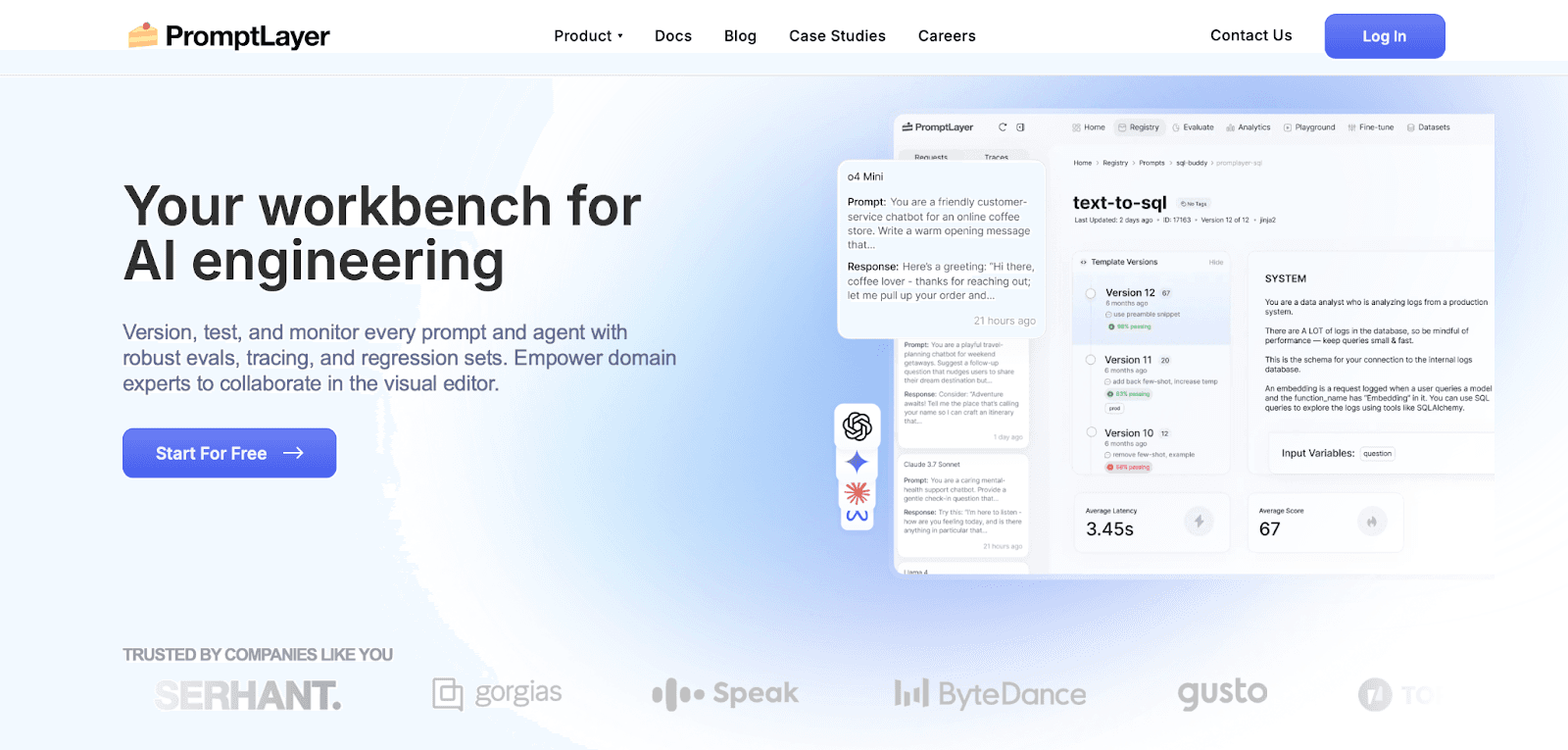
Image 2: PromptLayer
Platform 3: Helicone
Helicone is an open-source observability and prompt management platform designed to help teams monitor, debug, and optimize their AI applications. It allows developers to manage prompts as configurations separate from the application code, which enables faster iteration and experimentation.
Primary Use Case
As an LLMOps platform, Helicone focuses on enabling rapid iteration and experimentation with prompts without requiring new code deployments. This approach allows teams to test and deploy prompt changes instantly, which speeds up the development cycle and makes it easier to ship improvements.
Key Technical Features
Prompt-as-Configuration: It allows teams to treat prompts as configuration files that can be modified and deployed without needing to rebuild or redeploy the application.
Version Control & Rollback: The platform includes built-in version control that tracks every change to a prompt, with the ability to compare versions and instantly roll back to a previous one if needed.
Dynamic Variables: It supports the use of typed variables within prompts, allowing for the creation of flexible and reusable prompt templates that can be populated with different data at runtime.
Environment Management: It provides tools to manage and deploy different prompt versions across various environments, such as development, staging, and production, independently.
Pros
The platform allows for prompt iteration without requiring code changes, which accelerates the testing and deployment cycle.
It features built-in version control with the capability for instant rollbacks, helping to manage prompt history and mitigate issues quickly.
The use of dynamic variables offers flexibility, allowing prompts to be reused across different contexts and applications.
Cons
Its evaluation frameworks for testing prompt performance are considered less mature when compared to some competing platforms.
The observability dashboards, while useful for monitoring, may not offer the depth required for complex debugging and troubleshooting scenarios.
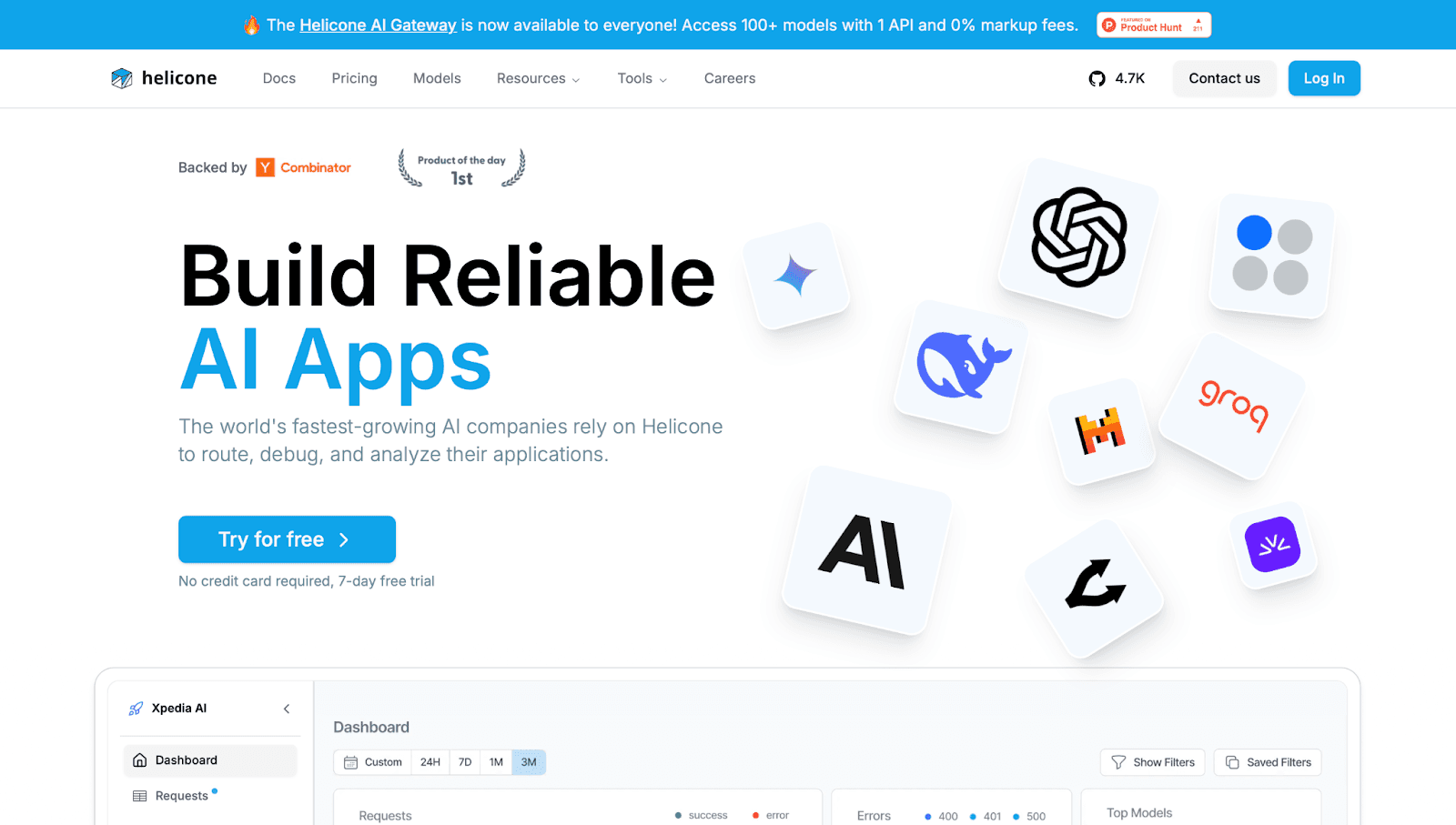
Image 3: Helicone
Platform 4: Portkey
Portkey is a production-grade AI gateway and LLMOps platform that unifies access to multiple language models while providing integrated prompt management and observability. It processes over 10 billion LLM requests monthly and is trusted by Fortune 500 companies and 16,000+ developers worldwide.
Primary Use Case
The platform serves as a full-stack LLMOps solution for enterprise AI teams that need unified access to multiple LLMs combined with integrated prompt management, observability, and governance. It is particularly valuable for organizations building production AI systems where reliability, cost control, and compliance are critical requirements.
Key Technical Features
AI Gateway: Portkey provides unified API access to 1,600+ LLMs with automatic routing and failover capabilities, eliminating the need to manage multiple API integrations.
Prompt Management: The platform offers centralized prompt versioning and deployment without hardcoding, allowing teams to manage prompts as configuration with folder hierarchies and version control.
Integrated Observability: Portkey includes a real-time monitoring dashboard to track LLM behavior, detect anomalies early, and manage usage proactively across all requests.
PII Redaction & Security: The platform automatically redacts sensitive data from requests before sending to LLMs and includes role-based access control (RBAC) with detailed activity logs for compliance.
Intelligent Caching: Request caching and smart routing strategies reduce costs by up to 40% and improve latency for repeated queries.
MCP Client Support: Integration with the Model Coordination Protocol simplifies tool calling and enables dynamic workflows for production-ready AI agents.
Pros
It delivers exceptional cost optimization through caching, with documented savings up to 40% for enterprise deployments.
The platform provides unified access to a diverse LLM ecosystem, making it easy to switch between providers or implement failover strategies.
Integration requires just three lines of code with minimal changes to your existing stack, allowing for rapid deployment.
Enterprise-grade governance and compliance features, including PII redaction, audit trails, and RBAC, meet strict organizational requirements.
It is used by 16,000+ developers and Fortune 500 companies, backed by a proven track record of 99.9999% uptime.
Cons
Setting up advanced gateway configurations and routing rules can have a learning curve for teams new to AI gateway concepts.
Pricing scales with token volume, which can become costly at enterprise scale where millions of requests are processed daily.
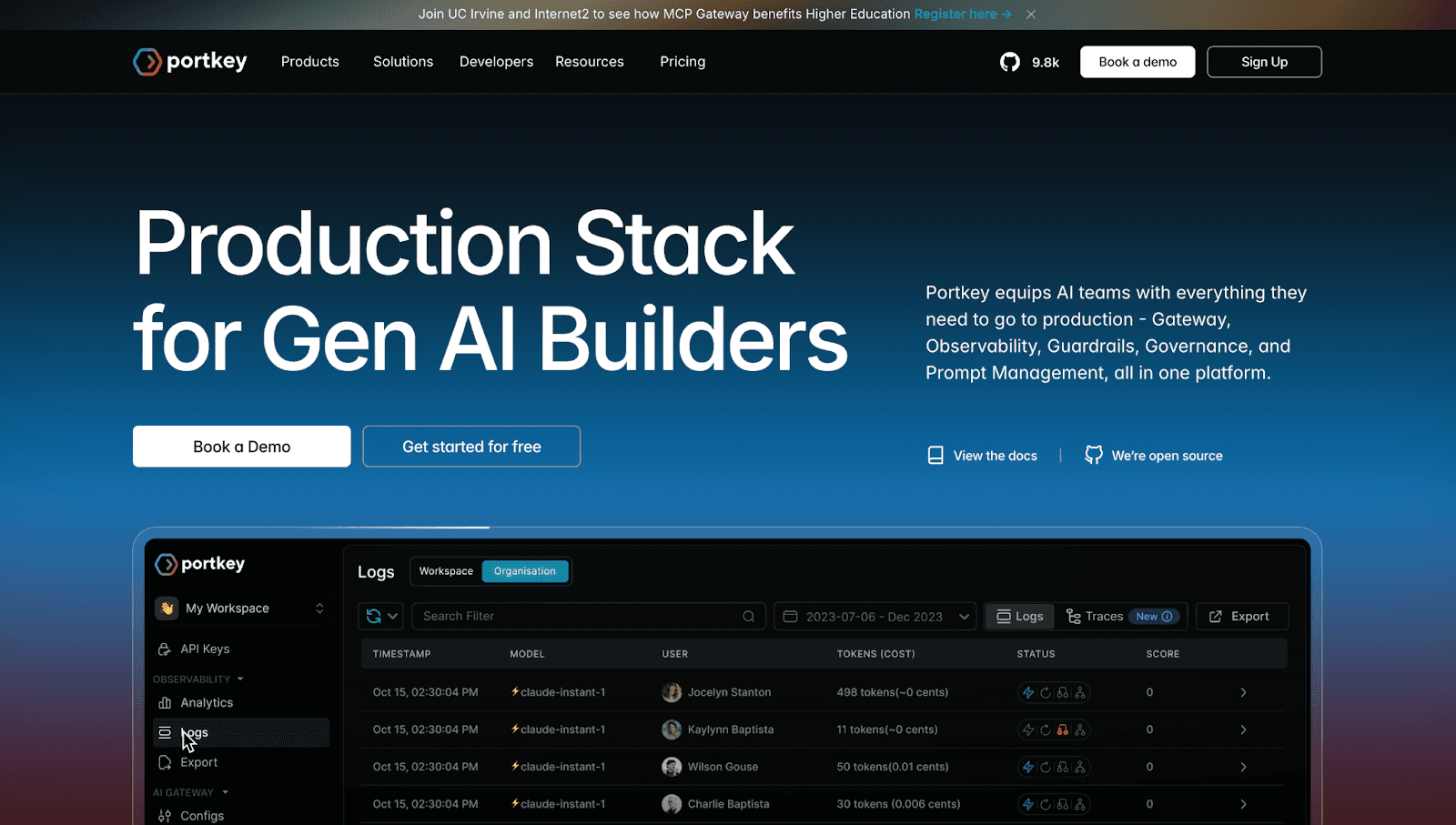
Image 4: Portkey
Platform 5: Agenta
Agenta is an open-source LLMOps platform focused on building reliable LLM applications by bringing prompt engineering, systematic evaluation, and observability into a single workflow. The platform aims to help technical and non-technical experts create, test, and deploy high-quality prompts without friction, streamlining collaboration for AI teams.
Primary Use Case
Agenta is built as an integrated solution for teams that want consistency and clarity across the AI development lifecycle. Its main strength is enabling systematic prompt management, offline and online evaluation, and detailed observability of LLM-powered applications in production, all from an easy-to-use web interface.
Key Technical Features
Integrated Playground: Agenta’s playground lets users compare prompts and models side by side, adapt them in different scenarios, and deploy changes with a few clicks. Experts can conduct rapid experiments and switch models or variables with no code.
Prompt Registry: The Prompt & Configuration Registry provides a centralized system for prompt history, branching, rollback, and side-by-side version comparison. It keeps teams organized and ensures prompt consistency throughout development and deployment.
Systematic Evaluation: Agenta helps teams move from subjective checks to systematic evaluations that can be run from the UI to analyze the quality of model outputs.
Observability Tools: The platform provides insightful dashboards and tracing tools to show how changes in prompts and models impact application performance, cost, and accuracy. Cross-functional teams can annotate traces and review model behavior together.
Pros
Agenta offers a comprehensive, end-to-end LLMOps solution with prompt management, evaluation, and observability integrated into one flow.
Its collaborative web UI empowers both technical and non-technical experts, making prompt engineering accessible to more stakeholders.
It helps accelerate development cycles by integrating prompt management, evaluation, and observability into a single workflow.
Cons
As a growing platform, it may have a smaller community and fewer integrations compared to more established tools.
Fully leveraging its advanced capabilities may require some initial setup and onboarding for teams.
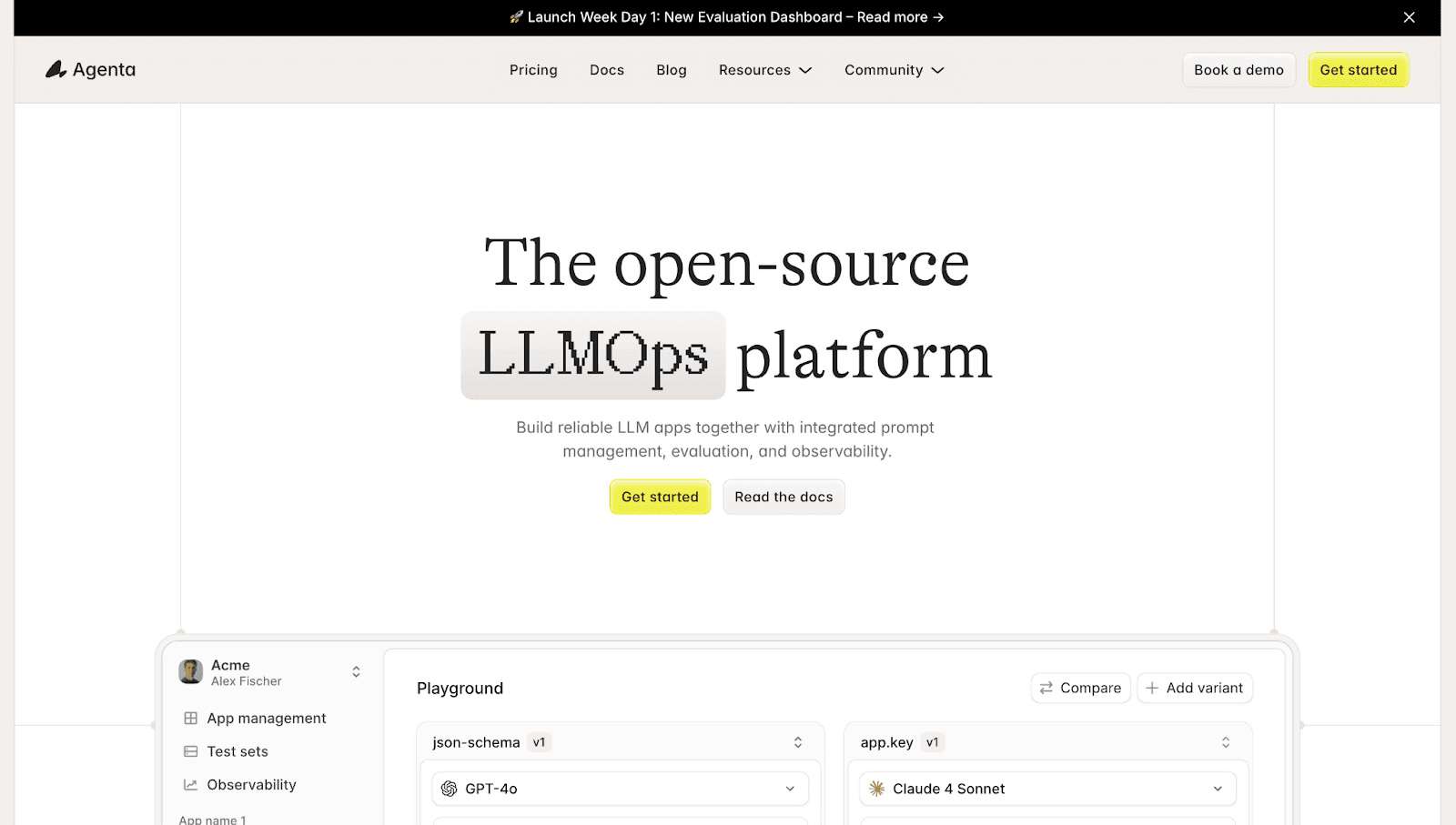
Image 5: Agenta
Platform 6: Arize
Arize is an enterprise-grade AI observability and evaluation platform designed specifically for building and monitoring production-grade AI agents and applications. It combines trace ingestion, prompt management, and evaluation tools to help teams debug, optimize, and iterate on AI workflows at scale.
Primary Use Case
The platform is purpose-built for development and observability of high-quality AI agents and applications with production-grade monitoring and evaluation. It is particularly useful for teams running complex agentic workflows that need deep visibility into decision-making processes, tool calling, and agent behavior.
Key Technical Features
Prompt Optimization with Auto-Suggestions: The platform provides automatic optimization using evaluations and annotations, with Loop agent analyzing prompts and generating better-performing versions.
Replay in Playground: The dedicated playground allows you to replay, debug, and perfect prompts with a workflow purpose-built for rapid iteration and testing.
Prompt Serving and Management: Arize enables you to manage prompts and serve optimizations quickly, allowing all team members to make changes without engineering involvement.
CI/CD Experiments: The platform integrates with your development pipeline to detect prompt and agent regressions early through evaluation-driven testing.
LLM-as-a-Judge: Power evaluation-driven development by automatically evaluating prompts and agent actions at scale with pre-built templates for tool calling, parameter extraction, and path convergence.
Span-Level Observability: Arize processes 1 trillion spans per month with detailed tracing for debugging complex agent flows, capturing every step including routing decisions, tool calls, and model outputs.
Pros
The platform offers advanced AI-assisted workflows through Loop for prompt optimization and includes synthetic data generation capabilities.
Extensive span-level tracing provides granular visibility into complex agent flows, making it easier to identify and fix issues.
It processes massive volumes including 50 million evaluations per month, demonstrating capacity for enterprise-scale workloads.
The platform uses OpenTelemetry standards for vendor-agnostic integration, giving you flexibility in your infrastructure choices.
Cons
Teams unfamiliar with MLOps concepts may experience a steep learning curve when getting started with the platform.
Effective use requires structured thinking about evaluation design and defining what success looks like for your specific use case.
Advanced features and custom configurations can be complex to set up and may require dedicated expertise to fully leverage.

Image 6: Arize
Platform 7: Braintrust
Braintrust is an AI evaluation and observability platform designed to help teams build, test, and monitor high-quality AI products with measurable outcomes. It combines evaluation workflows, prompt optimization, and production monitoring in a single platform to ensure AI applications meet quality standards before and after deployment.
Primary Use Case
The platform is focused on evaluation-driven development and production monitoring for teams building AI products where quality consistency matters. It enables organizations to systematically test prompts against datasets, optimize workflows with AI assistance, and catch quality regressions before they reach users.
Key Technical Features
AI-Assisted Prompt Optimization with Loop: Loop is an AI assistant that analyzes prompts and generates better-performing versions automatically, while also building and refining scorers to match your evaluation criteria.
Batch Testing: Run prompts against hundreds or thousands of real or synthetic examples to understand how they perform across different scenarios and edge cases.
Side-by-Side Diffs: Compare scores and traces of different prompts and models to see exactly why one version performs better than another.
Synthetic Data Generation: Loop creates evaluation datasets tailored to your specific use cases with the required volume and variety for comprehensive testing.
Production Monitoring: Track latency, cost, and custom quality metrics as real traffic flows through your applications in production.
Quality Gates & Alerts: Prevent quality regressions and unsafe outputs from reaching users through both automated scoring and human review capabilities.
Brainstore: A purpose-built database for AI data with scalable log ingestion that enables enterprise-scale searching and analysis.
Pros
The platform offers an intuitive evaluation framework that combines datasets, tasks, and scorers in a clear workflow.
AI-assisted workflows through Loop eliminate much of the manual overhead in creating and testing evaluations.
It supports hybrid deployment options including self-hosting, giving you control over your data.
Braintrust is SOC 2 Type II certified for compliance requirements in regulated industries.
It excels at catching quality regressions early through comprehensive CI/CD integration.
Cons
Initial setup can be complex for teams unfamiliar with systematic testing frameworks and evaluation design.
Advanced workflows may require significant configuration and domain expertise to fully implement.
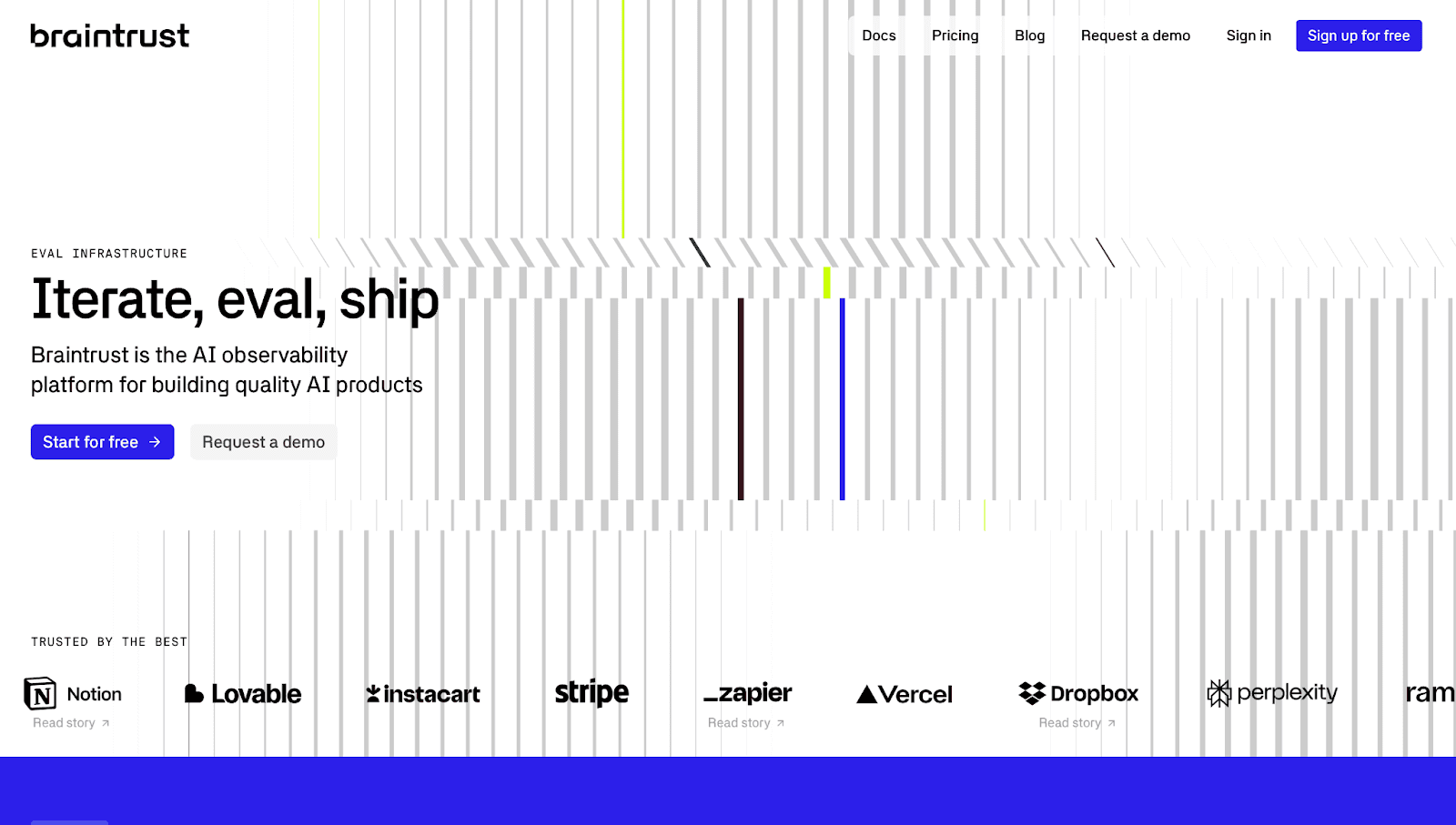
Image 7: Braintrust
Platform 8: Amazon Bedrock
Amazon Bedrock is a fully managed service from AWS that simplifies building generative AI applications by providing access to a wide range of foundation models (FMs). Its prompt management tools allow developers to create, test, version, and share prompts to get better and more consistent responses from these models.
Primary Use Case
Amazon Bedrock's prompt management is primarily for developers already working within the AWS ecosystem who need to experiment with and optimize prompts for different foundation models. It allows them to compare how various models from providers like Anthropic, Meta, and Amazon itself respond to the same prompt, all within a single, integrated environment.
Key Technical Features
Prompt Creation & Versioning: It provides tools to design, save, and iterate on prompts, with versioning to manage different configurations over time.
Multi-Model Testing: You can test and compare prompts across a variety of foundation models available in Bedrock, such as those from Anthropic, Meta, and Amazon.
Output Comparison: The platform offers a side-by-side view to compare the outputs from different prompt versions or models, helping to select the best one.
Automatic Optimization: It includes a feature that automatically rewrites and suggests improvements to prompts for better accuracy and more concise responses from the models.
Pros
The platform offers seamless integration with the broader AWS stack, including services like SageMaker and Lambda.
It allows for direct prompt testing and comparison across many different foundation models from various providers.
The service provides automatic prompt optimization suggestions to help improve performance with minimal effort.
Cons
Using Bedrock for prompt management creates a strong dependency on the AWS ecosystem, which can lead to vendor lock-in and make it difficult to migrate to other platforms.
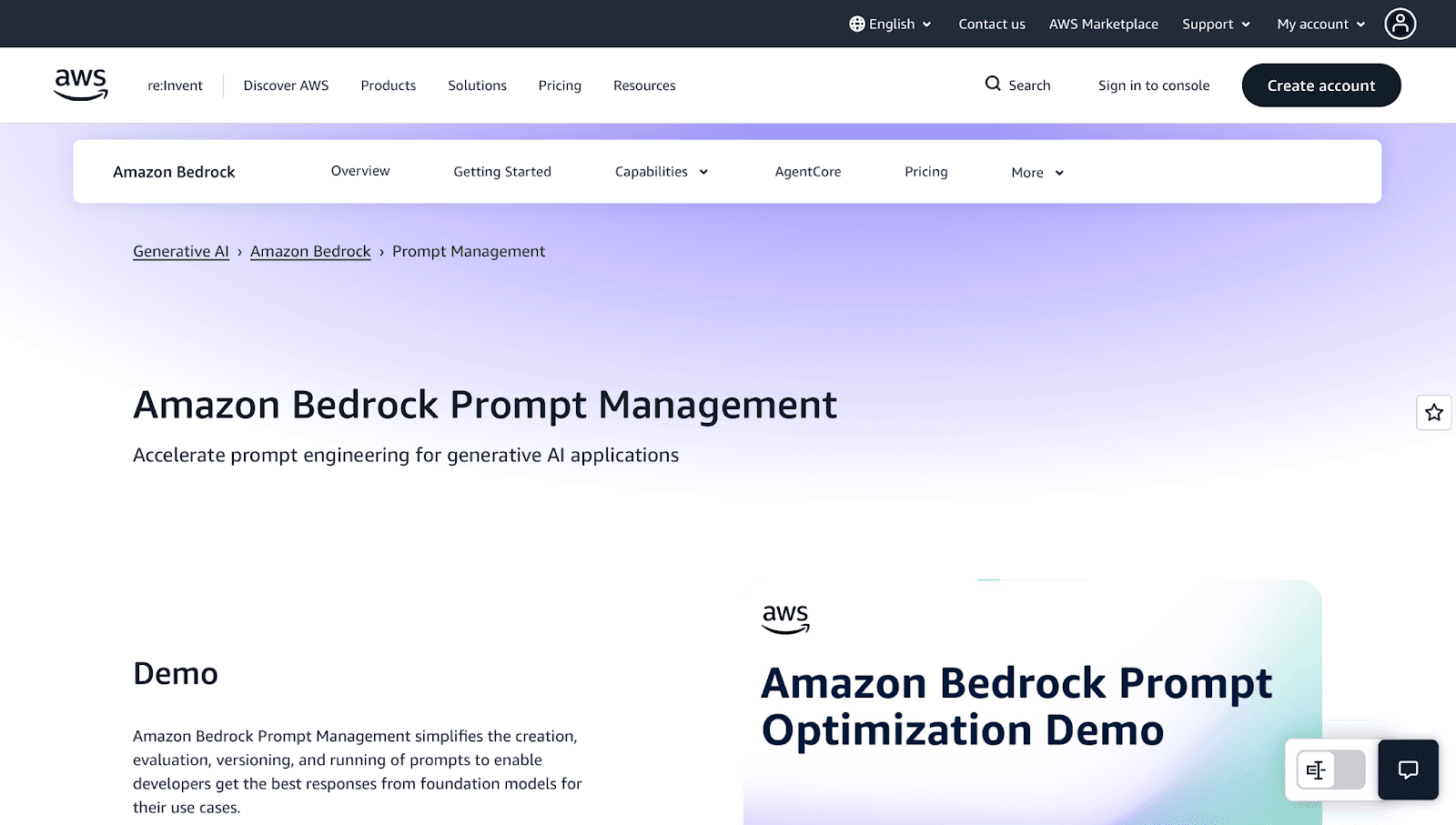
Image 8: Amazon Bedrock
Platform 9: PromptHub
PromptHub is a collaborative platform for prompt engineering where teams can discover, manage, version, and test prompts. It acts as a central home for hosting and sharing prompts, either publicly with a community or privately among teammates.
Primary Use Case
The platform is built with a collaboration-first approach, allowing enterprises to create a private or public hub for sharing and discovering prompts. This helps teams to organize, version, and deploy prompts using a simple API and community-driven tools.
Key Technical Features
Git-Based Versioning: The platform tracks all changes to prompts using a Git-style workflow, complete with commits and merge requests for better collaboration.
AI Writing Tools: It provides AI-powered assistance to help users write and refine their prompts for higher quality outputs.
At-Scale Evaluation: It offers tools to evaluate prompts across numerous test cases and compare the outputs side-by-side within a simple interface.
No-Code Chaining: You can create complex workflows by linking multiple prompts together using a point-and-click interface, without writing any code.
Pros
PromptHub has a strong focus on collaboration and discovery, allowing teams to share prompts privately or learn from a broader public community.
It features AI-powered tools for writing prompts and a straightforward interface for side-by-side output comparison during the evaluation process.
Cons
The platform's emphasis on community and public sharing may not be a good fit for enterprises with strict data privacy and security requirements.

Image 9: PromptHub
Platform 10: Langfuse
Langfuse is an open-source LLM engineering platform that helps teams debug and improve their applications by providing tools for tracing, evaluation, prompt management, and metrics. It integrates with popular frameworks like LangChain, LlamaIndex, and OpenAI to give developers detailed insights into their application's performance.
Primary Use Case
The platform offers open-source observability and analytics tools for logging and managing prompts, making it particularly useful for applications built with frameworks like LangChain. It is designed to help developers trace, debug, and analyze the behavior of their LLM applications from development to production.
Key Technical Features
Detailed Tracing: It provides step-level tracing and visualization for complex agent and chain flows, which is crucial for debugging and understanding application logic.
Dataset Management: The platform allows users to create and manage datasets, which can be used to run experiments and evaluate prompt and model performance over time.
Performance Monitoring: It includes dashboards for monitoring key performance indicators, including latency, cost, and the quality of model outputs across different versions.
Pros
Langfuse provides detailed, step-level tracing that is useful for debugging complex agent flows and understanding their execution paths.
The platform has tight integration with the LangChain ecosystem, allowing for easy setup with a callback handler.
It is primarily open-source, offering a self-hostable and flexible solution for teams that want more control over their tools.
Cons
Most of the functionality is closely linked to LangChain abstractions, which might be a limitation for teams not using that framework.
The evaluation suite is still in beta, and it does not have a built-in gateway, which means teams need to manage API keys and routing manually.
Self-hosting can be challenging to set up and maintain due to multiple infrastructure dependencies.
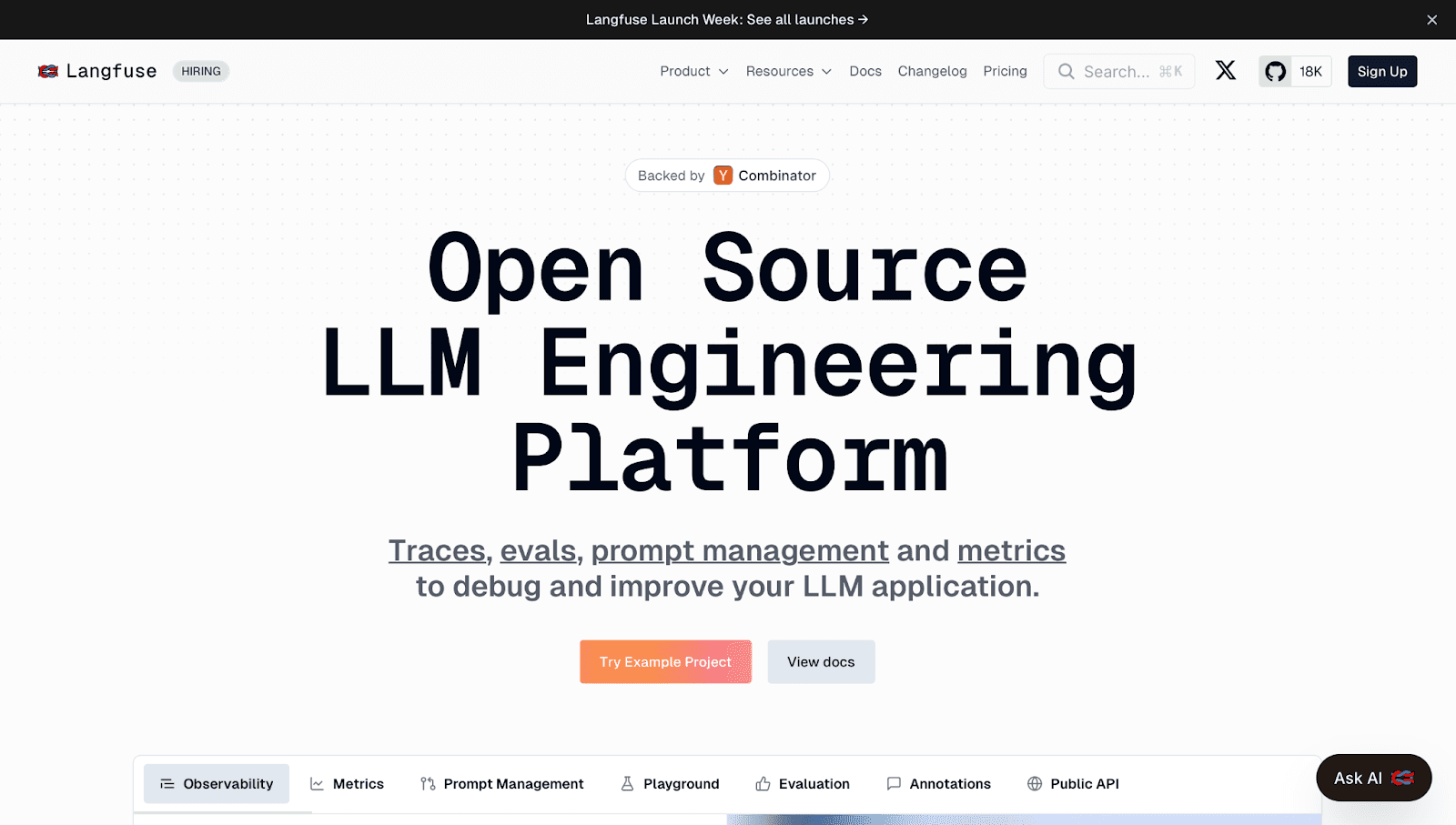
Image 10: Langfuse
Conclusion
The prompt management landscape provides a range of platforms to help you build and manage AI applications, with each tool offering a different approach to solving common development challenges. Your choice depends on your team's priorities, from comprehensive enterprise suites to focused open-source tools.
Here's how the tools break down:
For teams that want everything in one place: Future AGI, Portkey, and Amazon Bedrock handle the full stack. You get prompt management, evaluation, and production monitoring without juggling multiple tools.
For developers who iterate fast: Helicone, Langfuse, and Agenta let you push prompt changes without redeploying code. Version control and instant rollbacks mean you move quick.
For teams with mixed skill levels: PromptLayer and PromptHub bring non-technical people into the process. You get visual editors and easy collaboration so product managers and engineers work together.
For complex AI workflows: Arize and Braintrust give you deep visibility into agent behavior. Both tools handle intricate evaluation and let you catch issues before they hit production.
The right choice comes down to your use case, team size, and how you want to handle security and compliance. Some prefer self-hosted flexibility, others need a fully managed service. Start with what solves your biggest pain point today, then scale from there.
Future AGI handles the full prompt lifecycle: version your prompts, run evaluations against custom metrics, and deploy the best-performing version with one click. Start free, no credit card needed, and see how it fits your workflow.
FAQs











